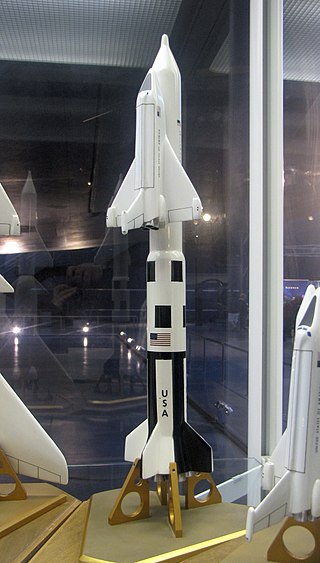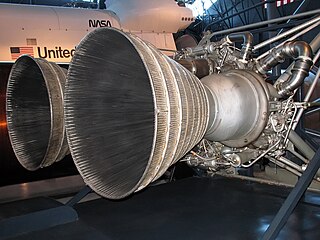
Operation Paperclip was a secret United States intelligence program in which more than 1,600 German scientists, engineers, and technicians were taken from the former Nazi Germany to the U.S. for government employment after the end of World War II in Europe, between 1945 and 1959. Conducted by the Joint Intelligence Objectives Agency (JIOA), it was largely carried out by special agents of the U.S. Army's Counterintelligence Corps (CIC). Many of these personnel were former members and some were former leaders of the Nazi Party.

In aerospace engineering, payload fraction is a common term used to characterize the efficiency of a particular design. Payload fraction is calculated by dividing the weight of the payload by the takeoff weight of aircraft. Fuel represents a considerable amount of the overall takeoff weight, and for shorter trips it is quite common to load less fuel in order to carry a lighter load. For this reason the useful load fraction calculates a similar number, but based on the combined weight of the payload and fuel together.
The Saturn INT-21 was a study for an American orbital launch vehicle of the 1970s. It was derived from the Saturn V rocket used for the Apollo program, using its first and second stages, but lacking the third stage. The guidance unit would be moved from the top of the third stage to the top of the second stage. The INT-21 was never flown.

The Saturn II was a series of American expendable launch vehicles, studied by North American Aviation under NASA contract in 1966, derived from the Saturn V rocket used for the Apollo lunar program. The intent of the study was to eliminate production of the Saturn IB, and create a lower-cost heavy launch vehicle based on Saturn V hardware. North American studied three versions with the S-IC first stage removed: the INT-17, a two-stage vehicle with a low Earth orbit payload capability of 47,000 pounds (21,000 kg); the INT-18, which added Titan UA1204 or UA1207 strap-on solid rocket boosters, with payloads ranging from 47,000 pounds (21,000 kg) to 146,400 pounds (66,400 kg); and the INT-19, using solid boosters derived from the Minuteman missile first stage.
The proposed Saturn IB-B was to be essentially an uprated Saturn IB using the new MS-IVB-2 upper stage, using the HG-3 engine, developed from the S-IVB and an uprated S-IB-A first stage.
The Saturn MLV was a proposed concept family of rockets, intended as a follow-on to the Saturn V. MLV stands for "Modified Launch Vehicle".
The Saturn C-8 was the largest member of the Saturn series of rockets to be designed. It was a potential alternative to the Nova rocket, should NASA have chosen a direct ascent method of lunar exploration for the Apollo program. The first stage was an increased-diameter version of the S-IC. The second stage was an increased-diameter version of the S-II. Both of these stages had eight engines, as opposed to the standard five. The third stage was a stretched S-IVB stage, which retained its original diameter and engine.

The Saturn-Shuttle was a preliminary concept of launching the Space Shuttle orbiter using a modified version of the first stage of the Saturn V rocket. It was studied and considered in 1971–1972.
The Saturn C-2 was the second rocket in the Saturn C series studied from 1959 to 1962. The design was for a four-stage launch vehicle that could launch 21,500 kg (47,300 lb) to low Earth orbit and send 6,800 kg (14,900 lb) to the Moon via Trans-Lunar Injection.
The C-2 design concept was for a proposed crewed circumlunar flight and the Earth orbit rendezvous (EOR) missions. It was initially considered for the Apollo lunar landing at the earliest possible date (1967).
The Saturn C-4 was the fourth rocket in the Saturn C series studied from 1959 to 1962. The C-4 design was proposed in 1960 for a three-stage launch vehicle that could launch 99,000 kg (218,000 lb) to low Earth orbit and send 32,000 kg (70,000 lb) to the Moon via trans-lunar injection. It met the initial requirements for a lunar orbit rendezvous and lunar landing mission.

The Saturn C-3 was the third rocket in the Saturn C series studied from 1959 to 1962. The design was for a three-stage launch vehicle that could launch 45,000 kilograms (99,000 lb) to low Earth orbit and send 18,000 kilograms (40,000 lb) to the Moon via trans-lunar injection.
Studied by Douglas Aircraft Company in 1965, this rocket consisted of a whole Saturn IB with 4 strap-on SRBs that have flown on the Titan 3E interplanetary missile carriers. All components of the vehicle have flown, but not together for this concept.

Skylab B was a proposed second US space station similar to Skylab that was planned to be launched by NASA for different purposes, mostly involving the Apollo–Soyuz Test Project, but was canceled due to lack of funding. Two Skylab modules were built in 1970 by McDonnell Douglas for the Skylab program, originally the Apollo Applications Program. The first was launched in 1973 and the other put in storage, while NASA considered how to use the remaining assets from Apollo.

This comparison of orbital launch systems lists the attributes of all individual rocket configurations designed to reach orbit. A first list contains rockets that are operational or in development as of 2022; a second list includes all retired rockets. For the simple list of all conventional launcher families, see: Comparison of orbital launchers families. For the list of predominantly solid-fueled orbital launch systems, see: Comparison of solid-fueled orbital launch systems.

Saturn V is a retired American super heavy-lift launch vehicle developed by NASA under the Apollo program for human exploration of the Moon. The rocket was human-rated, with three stages, and powered with liquid fuel. It was flown from 1967 to 1973. It was used for nine crewed flights to the Moon, and to launch Skylab, the first American space station.

The LR87 was an American liquid-propellant rocket engine used on the first stages of Titan intercontinental ballistic missiles and launch vehicles. Composed of twin motors with separate combustion chambers and turbopump machinery, it is considered a single unit and was never flown as a single combustion chamber engine or designed for this. The LR87 first flew in 1959.

The RS-27 was a liquid-propellant rocket engine developed in 1974 by Rocketdyne to replace the aging MB-3 in the Delta. Incorporating components of the venerable MB-3 and the H-1 designs, the RS-27 was a modernized version of the basic design used for two decades. It was used to power the first stage of the Delta 2000, 3000, 5000, and the first model of the Delta II, the Delta 6000.
A super heavy-lift launch vehicle is a rocket that can lift to low Earth orbit a "super heavy payload", which is defined as more than 50 metric tons (110,000 lb) by the United States and as more than 100 metric tons (220,000 lb) by Russia. It is the most capable launch vehicle classification by mass to orbit, exceeding that of the heavy-lift launch vehicle classification.
RS-56 was an American liquid-fueled rocket engine, developed by Rocketdyne. RS-56 was derived from the RS-27 rocket engine, which itself is derived from the Rocketdyne H-1 rocket engine used in the Saturn I and Saturn IB. Two variants of this engine were built, both for use on the Atlas II rocket series. The first, RS-56-OBA, was a booster engine, while the RS-56-OSA was designed for use as a sustainer and produced lower thrust but at a higher specific impulse.
Gerhard B. Heller was a German-American rocket scientist and member of the "von Braun rocket team." He worked at Peenemünde Army Research Center during World War II and later, through Operation Paperclip, moved to develop rockets for the U.S., eventually becoming employed at the Marshall Space Flight Center.










